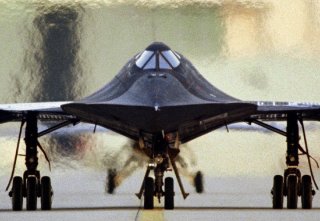This SR-71 Spy Plane Is All Fireball (As in the Fastest Plane Ever)
It is an iconic photo that has stood the test of time—an SR-71 Blackbird Mach 3 spy plane with a spectacular ball of flames trailing while putting on an amazing performance at the 1986 Air Fete Air Show.
It is an iconic photo that has stood the test of time—an SR-71 Blackbird Mach 3 spy plane with a spectacular ball of flames trailing while putting on an amazing performance at the 1986 Air Fete Air Show.
If you want to know more about what really happened that day and the taking of the photo, look no further than Richard H. Graham’s book SR-71 Revealed: The Inside Story.
Here’s what Lt. Col. Doug Soifer had to say: “On our very first TDY to Mildenhall, Mike Smith (the pilot) and I were lucky enough to be there for Air Fete—the big annual air show at Mildenhall. We got to fly the first day and thought we did a good job. During the 20 minute sortie we had a real hard kick during one pass when we went to afterburner and pulled up tight.”
He continued: “We didn’t think much about it until we landed and were overwhelmed by people as we stepped off the jet and asked us what we did. We had no idea what they were talking about until someone brought over his camcorder and showed us the tape.”
Then he began to describe the thirteen fireballs that came out of the aircraft’s exhaust.
“It looked beautiful, and people wanted to know if it could be done again,” he said. “They used the picture of us with the flames coming out for the next year’s Air Fete poster. Mike and I became known as the ‘Fireball Twins.’ The maintenance people figured it was the TEB (triethylborane) shooting out of its container and igniting the JP-7. With that start, we had an exciting six weeks in England.”
The SR-71 burned JP-7 fuel, one-of-a-kind fuel that is three times as expensive as the type used in airliners. In order to meet the specs of the aircraft, fuel-maker Shell Oil invented a compound blend of kerosene distillates—hundreds of hydrocarbons with all but 5 percent of the aromatics removed in processing.
Low aromatics point to the fact that it is a “clean” mixture, with low levels of impurities like sulfur, nitrogen, and oxygen. This JP-7 fuel allows for “high thermal oxidative stability”—or it is considered to be more predictable in extreme temperatures.
“To ignite the JP-7 for engine start, and to light the afterburner section, a liquid chemical ignition system was used. The liquid chemical, triethylborane, had the physical property of exploding when exposed to air,” according to the Aviation Geek Club.
“During engine start, rising fuel pressure in the fuel control signaled the ignition system that a metered amount of TEB could be injected into the engine combustion section, after the pilot moved the throttle from cut-off to the idle position. Preceded slightly by fuel, the TEB exploded and ignited the JP-7.”
Ethen Kim Lieser is a Minneapolis-based Science and Tech Editor who has held posts at Google, The Korea Herald, Lincoln Journal Star, AsianWeek, and Arirang TV. Follow or contact him on LinkedIn.

